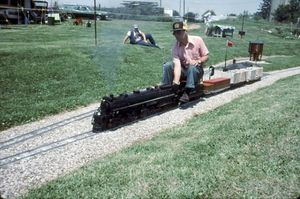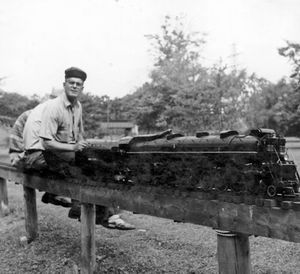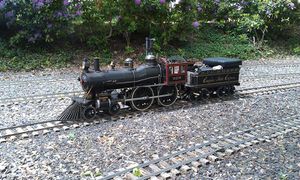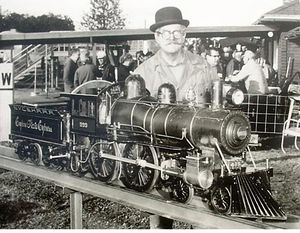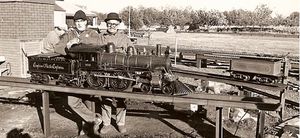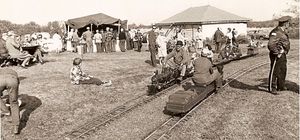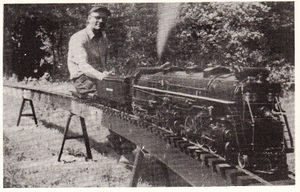Fred Bohn
Photo Gallery
The picture of the 4-6-6-4 is the one made by Fred Bohn. The Hoffmans bought the engine from him and then eventually sold it to a private museum in Huntsville. It then went to H Saville then to a gent in Texas I hear. Photo by Steve Bratina.
Fred Bohn (USA) operating his UP Challenger locomotive at a meeting in Central Park, Islington (TSME Acres) - 1952.
Here is a photo of the 999 built by Fred Bohn in Niagara Falls NY. It's 7 1/4" gauge and is coal fired. A few years back she received a full cosmetic restoration. Photo by Steve Dispenza.
Marty Knox wrote: That's Fred Bohn with his 1 1/2" scale 7 1/4" gauge NYC 999 at the Brotherhood meet in 1972. This was hosted by the Pioneer Valley Live Steamers in Southwick, Massachusetts. Derbies or Bowlers were common headgear worn by locomotive engineers in this country in the 1890's.
Fred Bohn on the right with the late Adrian "Doc" Buyse. The handsome 999 which is so famous from the New York Central & Hudson River Rail Road "Empire State Express" was built by Fred. Photo by Bob Hornsby.
The train on the left is Fred Bohn with his beautiful 999 "Empire State Express." Fred's entire train had working air brakes! The train on the right going away from the camera is Bud Hansen with the late Walter Bush's 4-4-0. Photo by Bob Hornsby.
Fred Bohn of Bridgeport, Conn. and his Union Pacific 4-6-6-4 on the Main Line of Waushakum Live Steamers meet, 1956. From The North American Live Steamer, Volume 1, Number 6, 1956.
3/4 inch Challenger
Around-About Bridgeport
by William Lamale
The Bridgeport Telegram, Monday, October 10, 1955
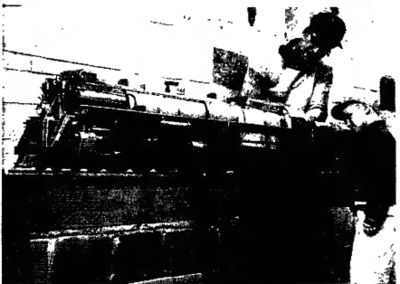
One of those things guaranteed to win and hold the attention of neighborhood youngsters is a real, coal-burning locomotive parked in the back yard, with a full head of steam.
Not only will the youngsters and all their pets be interested, avers Fred J. Bohn, but also the grown-ups, and that includes the milkman, postman, meter reader, refuse collectors, and other passers-by.
Of course, Fred doesn't have a life-sized locomotive sitting out there next to the dahlia bed behind his apartment at 703 Brewster Street. But he does have a copy of the Union Pacific Challenger type engine, a three-quarter inch to the foot reproduction of the actual things.
But Fred's locomotive is so large that two men are required to heft it, and on tracks the junior-sized Iron Horse can haul eight humans sitting cross-legged on model flat cars.
The only locomotive of its kind in Bridgeport rests on a short stretch of track mounted on a wooden trestle. Its strictly a test stand, the driving wheels turning a treadmill.
About the only time the big model gets open track under its drive wheels is when Fred loads it into the trunk of his car and goes in regional meets of the New England Live Steamers association in Danvers, Mass., or in Freeport, N.Y. In Freeport, there is 800 feet of three-and-a-half inch where model builders like Fred can try out their locomotives, freight cars, passenger cars, gondolas or cabooses.
When these model tracks are closed, Fred uses his backyard stand to do maintenance work on the Challenger.
Fred grew up near the Erie line in Scranton, PA, and as a youngster used to wave at the engineers. Later he worked summers with a track crew and once was privileged to ride in the cab of a switcher.
Then he learned the sheet metal trade and got away from railroads.
But in 1949 he joined the live steamers and got the prints for the Challenger. It took him five years or 5,050 hours to build the model. He machined and assembled everything himself in his own workshop except several special castings which were made at Eullard's.
Just a year ago Fred got up the first steam in the Challenger.
"Here, I'll show you how it's done." he offered yesterday afternoon. He uses a crushed grade of Pocahontas coal, soaked in kerosene, to fire the boiler. After spooning about two pounds of it into the firebox, he switched on a vacuum cleaner suction device attached to the stack of the Challenger. This creates an artificial draft until the fire under the boiler makes its own. Then he ignited the fuel with a match.
"It takes 18 minutes to build up 90 pounds of steam" he announced.
The Challenger has four high-pressure cylinders slightly thicker than thread spools, and her front chassis swivels to allow for turns in the track. She's a long engine (five feet). Here boiler holds three and a half gallons of water.
Fred says she develops enough power to haul 15 persons, if there were enough space to seat them. Her full sized counterpart was a heavy duty engine designed to pull freight in the Sierras.
The model has a stainless steel inlet and a copper smokebox. Her piping, flues and trim are copper too.
At model meets Fred sits on a flat car hitched to the tender and adjusts the speed of the locomotive by a cable extension attached to the throttle.
Like the real locomotive she is the Challenger huffs and puffs, blows clouds of smoke and pumes of steam. At a standstill she makes all the impatient hissing and clanking noises of an engine in the station.
Locomotive fans be they railroad men or not, just naturally fall in love with all 275 pounds of her. She does in miniature everything that a fullsized Challenger ever did, and has all the gauges and instruments, too.
Her whistle blows and the bell tinkles. After dark the headlight shines and the redhot firebox glows.
Many of the live steam fans are retired locomotive engineers.
They like to sit at the controls of the Challenger and once again sniff soft coal smoke as she whizzes down the track.
